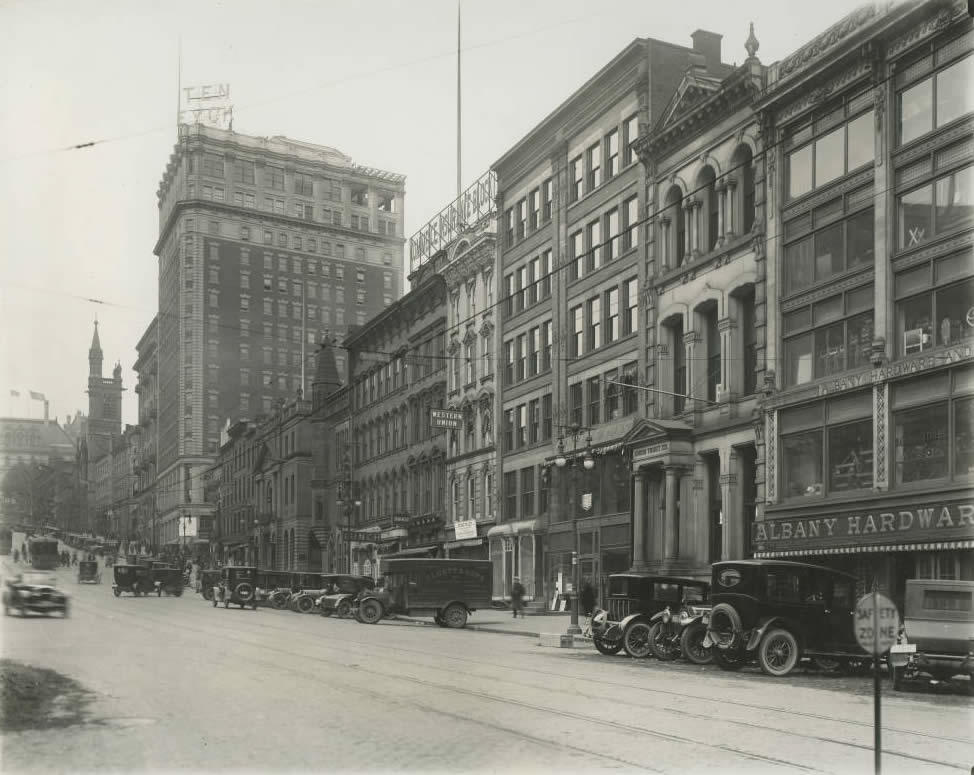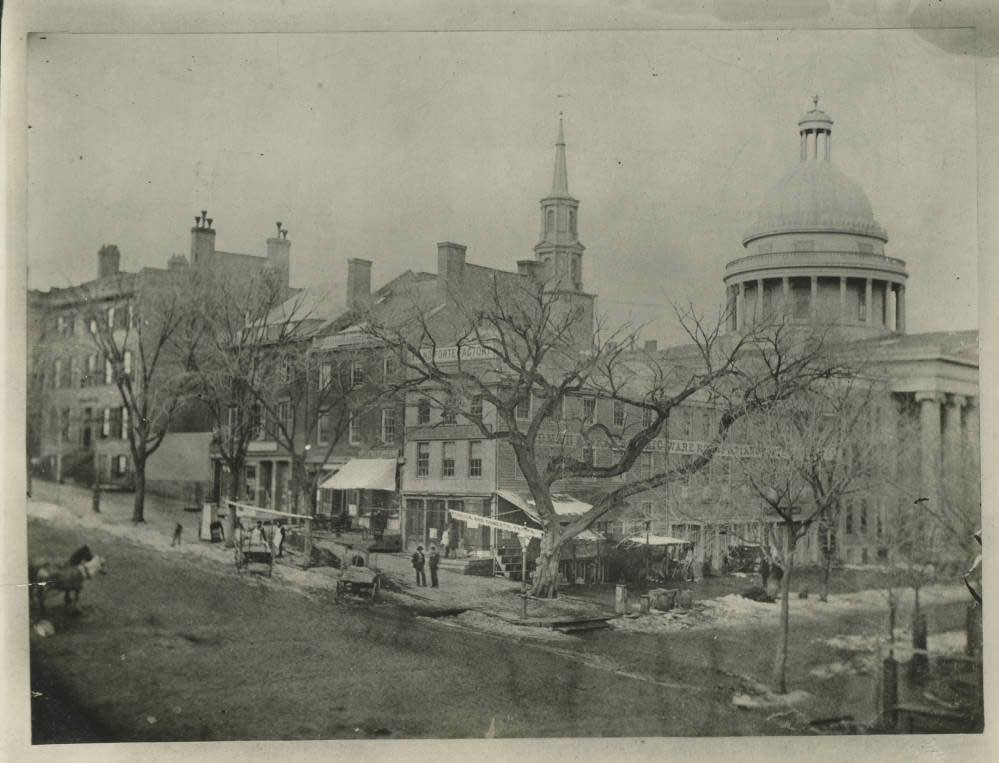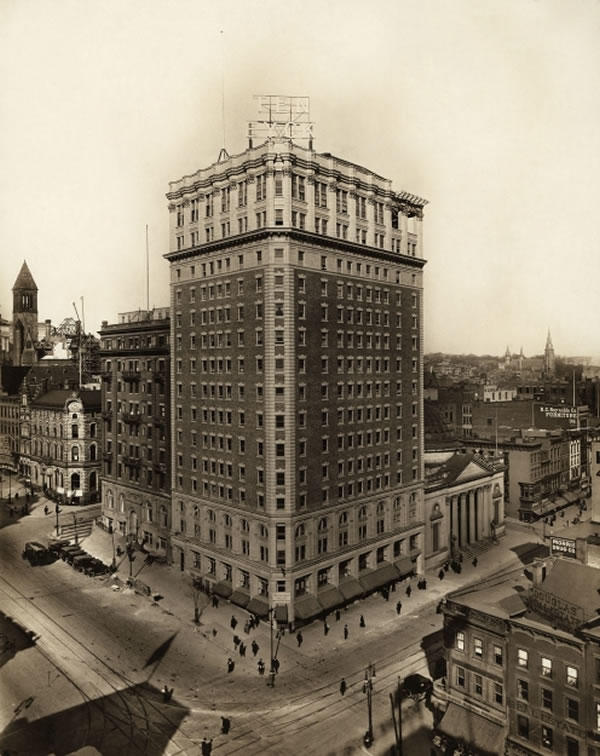One corner, many different buildings

Looking up State Street to Pearl Street in (we're guessing) the 1920s. That's the old Ten Eyck Hotel on the northwest corner. / photo via Albany Public Library History Collection
The northwest corner of State and Pearl in downtown Albany is one of the city's most prominent and historic spots. And as Mike DeMasi reported this week, SUNY is buying the office/bank building there. [Biz Review]
The 1970s-era building that's currently on the site is an odd fit -- its size, its style, the way it sits on such a busy corner but is largely closed off to the sidewalk. It sticks out even even more when you view the building in the historical context of what's stood there before.
So, let's take a quick look at that...
A detailed history of the Elm Tree Corner
Before we go any farther, if you're interested in a detailed history of the corner, head over to the Friends of Albany History, who chronicled much of its history earlier this year. The story stretches back more than 300 years and includes a famous elm tree that was said to have been planted by Philip Livingston.
We're going to pick up the architecture a bit more recently.
Mid 1800s

This photo, from the Albany Public Library History Collection, is dated to 1849. During this period, the building on the corner was the Boardman and Gray piano company and it very much fit with the context of the time. And, yep, that tree on the corner was the elm.
Tweddle Hall

By 1859 the old piano company building had been demolished for Tweddle Hall, built by the malt merchant and banker John Tweddle. It included an auditorium that served as a key meeting place and event space. Head over to Hoxsie to see Carl Johnson's post about the history of this building.
Based on this photo from the Albany Public Library History Collection, it looks like the first Tweddle Hall (foreshadowing) was a beautiful building. Check out all the street-level retail space, the way it opens to the sidewalk and sits on the corner.
The Tweddle Building
But the first Tweddle Hall caught on fire in January 1883, "rendering the interior almost a complete wreck" as the New York Times reported. And so the second Tweddle Hall was constructed (this time without the auditorium). This photo is from the rabbit hole of local historical photos that is the Albany Group Archive on Flickr.
The replacement is a bit more plain than the original, but it's still a relatively handsome building and it sits nicely on the corner. And note the retail spaces that open to North Pearl Street.
The Ten Eyck
The second Tweddle Building didn't have a long life, eventually making way for an expansion of the Ten Eyck Hotel. Here's the first section of the Ten Eyck Hotel, standing just "up" State from the second Tweddle Building, in 1901. This view is looking "down" State Street, so the Tweddle Building is to the right. (That connecting street in the foreground is Chapel Street, which no longer goes through.)

photo: Detroit Publishing Co. via Library of Congress
The Ten Eyck expanded in the mid 1910s, taking over the footprint of the Tweddle. And the new hotel building was tall (relatively). This 1916 photo is from the Albany Institute of History & Art.

It definitely stood out. (See the photo at the top.) But it was soon joined in 1926 by the also-tall New York State National Bank Building on the corner just across Pearl at 69 State Street and the Home Savings Bank Building at 11 North Pearl in 1927 (which was the tallest building in Albany at the time).
Here's the corner, looking north along Pearl Street, in 1947. The Ten Eyck really commanded that corner, standing close to the street.

photo: Albany Public Library History Collection
Ten Eyck Plaza
In the 1960s downtown Albany was already feeling the strain from forces such as suburbanization. And the Ten Eyck Hotel was out of business by 1969, its contents liquidated.
In 1970, the New York State Urban Development Corporation -- the forerunner of today's Empire State Development -- hired an architectural firm to study the redevelopment of three blocks in downtown Albany, including the Ten Eyck site. (The UDC had been created in 1968 during the Rockefeller administration to, as the Times Union explained at the time, "tear down and rebuild slums even if the locality objects.")
The agency, in conjunction with the city of Albany, eventually expanded the redevelopment zone to include the four blocks bounded by State Street, Lodge Street, Pine Street, and North Pearl Street. (Erastus Corning was apparently keen on the idea of building a large parking garage.) The idea was to package blocks together to better attract large-scale development.
And that's how we ended up with what's there today -- the large Ten Eyck Plaza block, which includes state offices, the Hilton hotel, a parking garage -- and the office/bank/Starbucks building on the corner of State and Pearl, which is still owned (for the moment) by a subsidiary of Empire State Development.
We've always felt this building just didn't quite sit right on this corner. There's something about its height and placement that's a little odd. And, probably more importantly, its street level is mostly closed off from the sidewalk. Considering how much traffic that intersection gets, that's a lost opportunity.
Parking Lot District / former convention center site
One more thing, in a bit of a tangent: Reading some of the old clippings about the Ten Eyck Plaza redevelopment, we couldn't help but think about the former convention center site on the southern side of downtown Albany -- AKA, the Parking Lot District -- that's up for (eventual) large scale redevelopment.
Last year, Empire State Development released a report outlining some conceptual ideas for the site. And it looks like Capitalize Albany -- the economic development art of the city of Albany -- will at some point get control of the land. It will be interesting to see whether there's anything the city can learn from its past experiences as it pursues the future there.
Earlier
Say Something!
We'd really like you to take part in the conversation here at All Over Albany. But we do have a few rules here. Don't worry, they're easy. The first: be kind. The second: treat everyone else with the same respect you'd like to see in return. Cool? Great, post away. Comments are moderated so it might take a little while for your comment to show up. Thanks for being patient.

Comments
There is a lot to be said about small scale redevelopment. On a per-block level, a dozen or so small lots often outperform one big project that covers the whole block.
... said Zed F on May 16, 2018 at 10:16 PM | link
With SUNY as the owner, will the city now get no tax revenue from this property? If so, it's a bad deal.
... said PK on May 17, 2018 at 7:32 AM | link
disappointing to read that another commercial parcel will be coming off the tax rolls. With the State continuing to erode the city's tax base, the legislature should not squawk about funding in extra money for the capital city, and ought to come up with a permanent solution (Payments In Lieu Of Taxes (PILOT) for state owned buildings and land? increasing the per capita aid to levels enjoyed by Syracuse, buffalo, etc? Turning over the Harriman Office Campus to the city for development (while retaining its buildings, of course)? Or a combination of all of the above.
... said jsc on May 17, 2018 at 9:18 AM | link
The tax status is not changing. According to the Business Review article, "It's tax-exempt, and will remain that way under SUNY's ownership."
... said Reader on May 18, 2018 at 4:03 PM | link